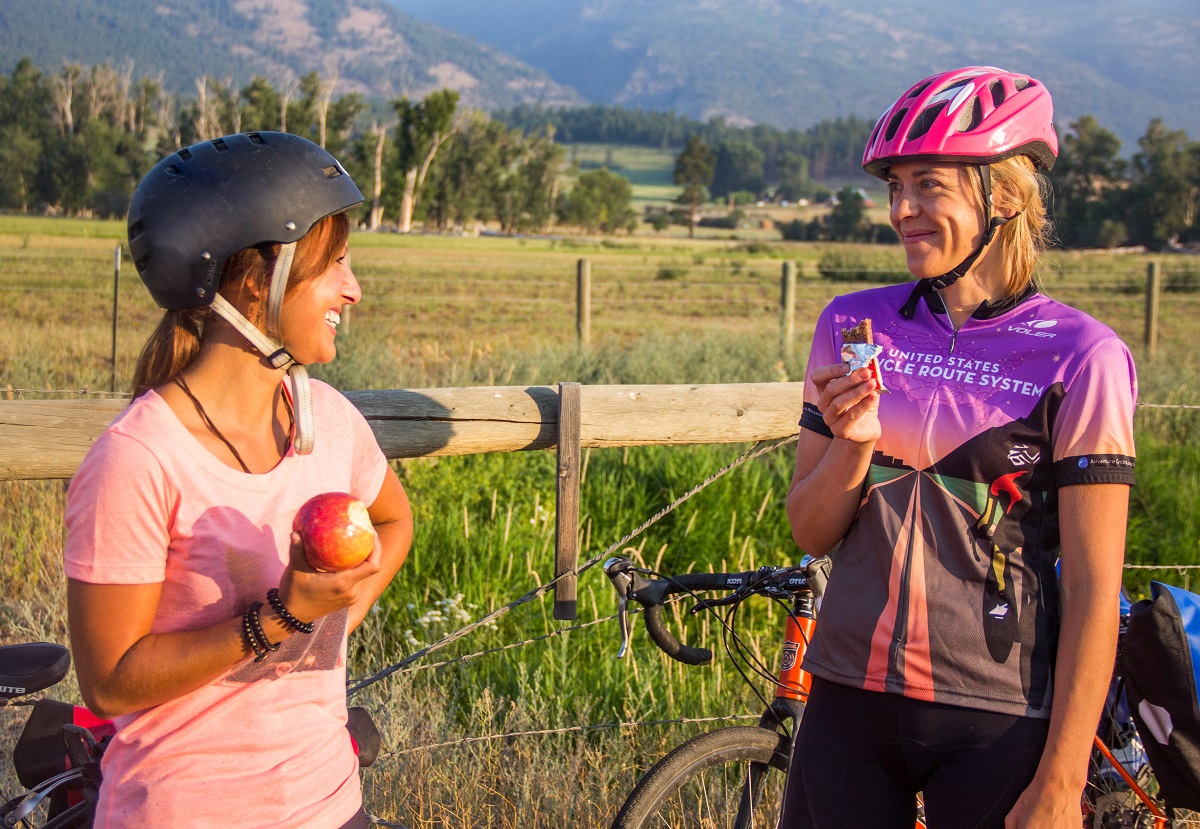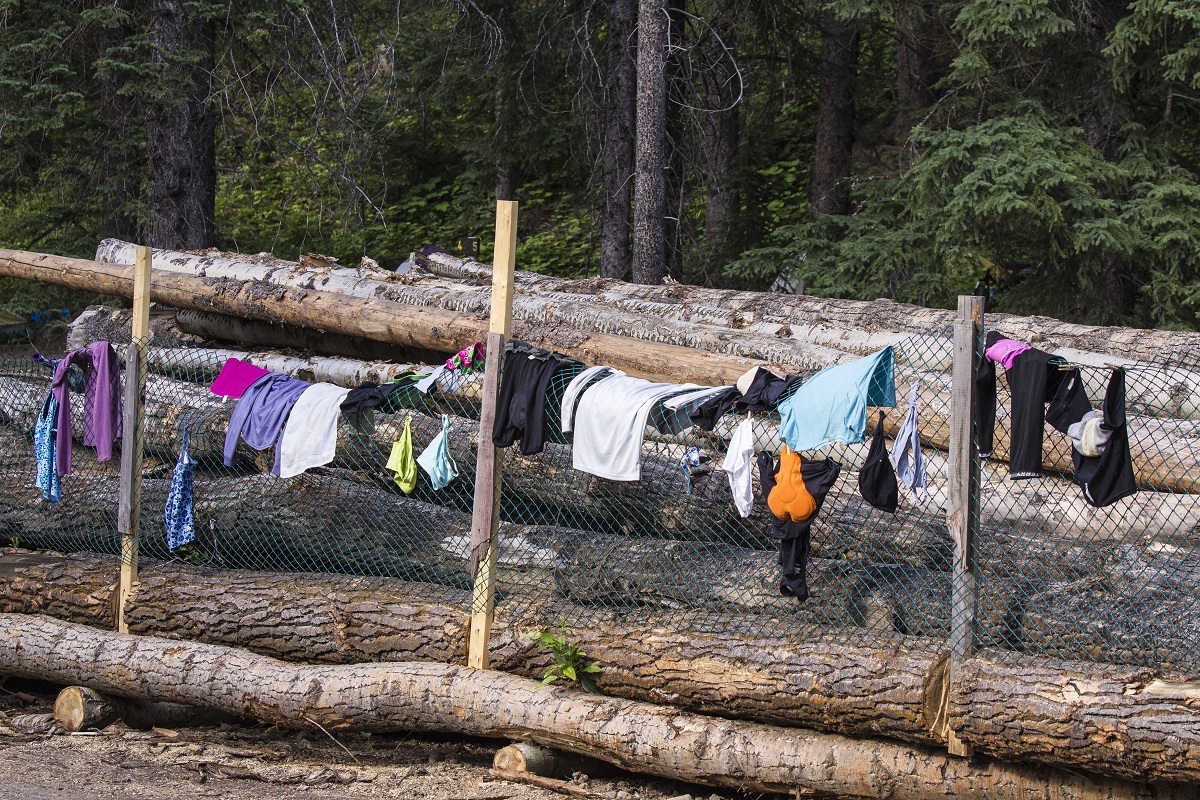Nutrition and Hydration Tips
You might consider the three legs of getting your body ready for bicycle touring to be conditioning, nutrition, and hydration. You’re not just training your legs to go around in circles and push the pedals, you’re also fine-tuning the internal engine that drives the pistons.
No matter how much riding you do, your body will not fire on all cylinders if you’re not adequately fueled and hydrated. Part of the training regimen is practicing for what and how you’ll eat and drink when on the road.
It’s no exaggeration to say you might need twice your typical daily caloric intake and three times your fluid intake during long days in the saddle. You may even need to eat and drink when you’re neither hungry nor thirsty in order to avoid “bonking” and more serious problems that can result from dehydration.
Nutrition
Sample various foods before, during, and after your training rides to see what works for you, to learn what makes you feel supercharged versus simply satiated. Shoot for a varied diet — you know, like you’ve always been told but typically ignored: plenty of fruits and vegetables. And eat breakfast! It’s hard to beat a whole grain cereal with milk or yogurt, with fruit added, as a nutritious combo of protein and carbohydrates.
Carbs, by the way, are key to fueling up and restocking muscles. If you love pasta, bread, and potatoes, but try to avoid them because of their “fattening” reputation, this is the time to forget all that and live a little. Remember that carbohydrates fuel the workout, while protein aids in recovery, in the building and repairing of muscle tissue. And healthy fats like olive oil help reduce inflammation and support the absorption of vitamins, which are best obtained by eating plenty of colorful vegetables like broccoli, tomatoes, spinach, and peppers, along with cantaloupe, oranges, strawberries, and other fruits.
Energy bars are fine and convenient, but they’re an expensive replacement for the nutrients you can obtain just as readily by eating real food like bananas, fig bars, trail mix, and so on. Food items rich in iron include meats like beef and dark-meat chicken.
If you’re a vegetarian, good substitutes include iron-fortified breakfast foods. Non–meat eaters should also include a substantial quantity of plant protein at mealtime, e.g. hummus on whole wheat bread or peanut butter on a bagel. Other good stuff includes nuts, lentils, and dehydrated veggies (which are great for making soups when camping).

Eat up and don’t let yourself get too hungry. That’s when you’re prone to grabbing the nearest edibles in sight, like chips and ice cream. Finding nutritious, high-quality food can be tricky when you’re on the road, especially in certain parts of the country and world. But if you practice good eating habits before leaving home, at least you’ll know what to be looking for once you get out there.
When you’re on tour, during the day — that time between breakfast and dinner — eat lightly and eat often, and drink water or sports drinks regularly. You’ll be providing high-octane fuel for your engine, helping to repair damaged tissue, and replacing vital electrolytes like sodium, calcium, potassium, and magnesium.
These electrically charged minerals and compounds are key to maintaining muscle function, balancing your blood pH level, and warding off cramping and other heat-related issues. Think salty foods like SPAM-and-cheese sandwiches with mustard and pickles for sodium, and, for potassium, bananas, orange juice, apricots, and avocados.
Hydration
On tour, when you’re not drinking you should at least be thinking about when you will take the next drink. You lose water at an accelerated pace while cycling, from both sweating and respiration. This is especially true in the western mountains and other low-humidity surroundings — you may think because your clothes are not getting damp that you’re not sweating. So not true! It’s evaporating into the dry, thirsty air. So drink, drink, drink.
Fluids help keep your core temperature down, aid the blood in transporting nutrients, and flush the body of lactic acid and other metabolic by-products. A bottled sports drink or powder mixed with water can help replace electrolytes like sodium and potassium, but straight water with the right foods can do this just as well.
Again, practice the art of hydrating during your training rides. Weigh yourself before and after these rides a few times to learn approximately how much fluid you lose under different weather conditions and distances. With this information in hand, try to drink 16 to 20 ounces of water or sports drink for each pound of body weight you lose.
Another clue is the urine test: you should have to pee every two or three hours, and the urine should maintain a pale-yellow color. To top things off, prehydrate by drinking in the mornings before riding, and drink after the day’s ride is over. Down 12 ounces of water before that 12 ounces of beer, as alcohol can act as a diuretic.
On tour, you can typically get by with two or three water bottles, filled in the morning and again during the day as necessary. If you’ll be riding in a particularly arid and/or remote area, you might think about strapping on a hydration waist pack or backpack, which come in a variety of capacities. A portable water filter is another potential solution to the common challenge of clean water procurement.
Special Concerns: Heat, Heights, and Hygiene
It can get hot out there, especially if you’re touring in the South or in the deserts of the West during the summer. In such situations, plan to get most of your miles in during the mornings. If necessary, you can take an afternoon break in the shade, then put in a few more miles in the early evening. Pound down the fluids, and don’t forget to wear a high-SPF sunscreen.
At elevations above 7,000 feet or so, which are common in the Rocky Mountains (especially Colorado), as well as in many other parts of the world, you may experience signs or symptoms of altitude sickness, such as shortness of breath, fatigue, nausea, and headaches. To acclimate, cover shorter mileages the first few days at altitude, limit your coffee and alcohol intake, get lots of rest, and — do we sound like a broken record? — drink lots of water.

And don’t neglect keeping yourself clean. This not only will make you more socially acceptable, but it can also help prevent blisters, saddle sores, and infections. Keeping your hands clean can also stave off food-borne illnesses. For those times when you don’t have access to a shower, you can still wash up in a stream or at a campground water spigot. Additionally, a packet of baby wipes is small and light, and one or two wipes can work wonders in freshening you up at the end of a long, hot, sweaty day in the saddle.

